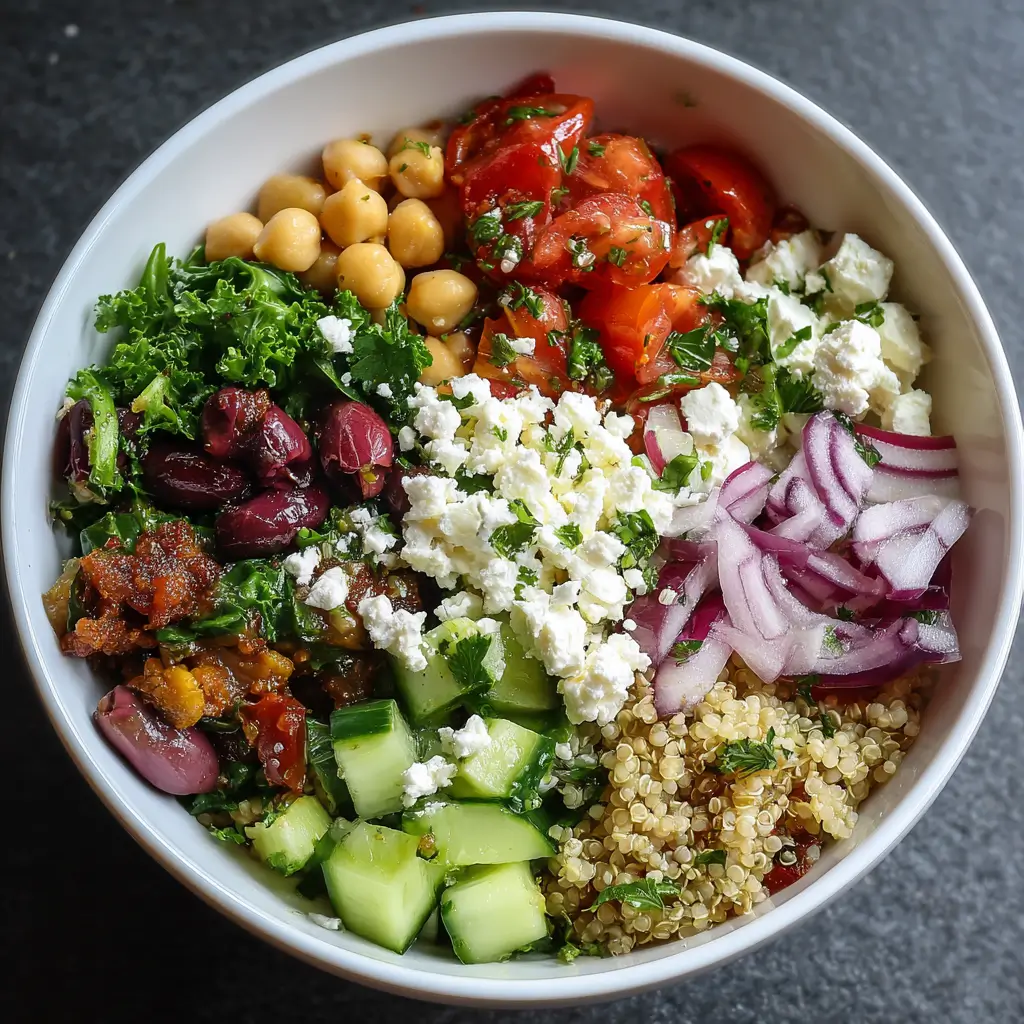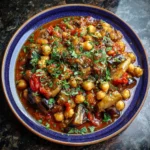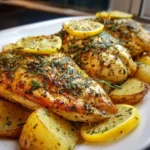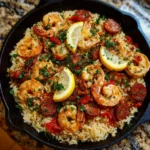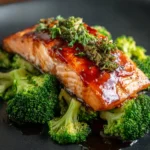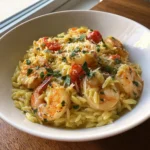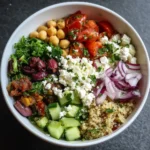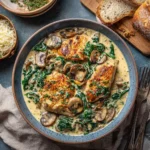Mediterranean Quinoa Salad Bowls
The Mediterranean Quinoa Salad Bowl is more than just a dish—it’s a celebration of vibrant flavors, wholesome ingredients, and the timeless culinary traditions of the Mediterranean region. Revered for its balance of taste, nutrition, and visual appeal, this bowl has become a global favorite among health enthusiasts, foodies, and busy professionals alike. Combining protein-rich quinoa with colorful vegetables, briny olives, creamy feta, and zesty herbs, it’s a meal that nourishes both body and soul.
The History
While quinoa itself originates from the Andean regions of South America, where it was cultivated by the Incas over 5,000 years ago, the concept of combining grains with fresh vegetables, legumes, and cheeses is deeply rooted in Mediterranean cuisine. Countries like Greece, Turkey, Lebanon, and Italy have long embraced grain-based salads such as tabbouleh, bulgur pilaf, and farro salads—dishes that emphasize seasonal produce, olive oil, and aromatic herbs. The modern fusion of quinoa with Mediterranean ingredients emerged in the early 21st century, as health-conscious cooks sought gluten-free, high-protein alternatives to traditional grains. This innovation led to the creation of the Mediterranean Quinoa Salad Bowl—a dish that pays homage to ancient culinary wisdom while embracing contemporary dietary needs.
Ingredients Breakdown
The magic of this salad lies in its diverse yet harmonious ingredients. Each component contributes not only flavor but also texture, color, and nutrition:
- Quinoa: A complete protein containing all nine essential amino acids, quinoa serves as the hearty base. It’s naturally gluten-free and rich in fiber, magnesium, and iron.
- Cucumber: Adds crisp freshness and hydration. Best when peeled or unpeeled depending on preference, and diced into small cubes.
- Cherry Tomatoes: Bursting with sweetness and lycopene, these are halved for easy eating and vibrant color contrast.
- Red Onion: Offers a sharp bite; soaking in cold water reduces pungency if desired.
- Kalamata Olives: These briny, purple-black olives bring authentic Mediterranean flair and heart-healthy monounsaturated fats.
- Feta Cheese: Typically made from sheep’s or goat’s milk, feta adds creaminess and tang. Can be crumbled or cubed.
- Chickpeas (Garbanzo Beans): A plant-based protein powerhouse, they add substance and make the bowl more filling.
- Red Bell Pepper: Sweet, juicy, and rich in vitamin C, it enhances both color and crunch.
- Fresh Herbs: Parsley and mint are staples—parsley lends earthiness, while mint brings a cool, refreshing note.
- Lemon Juice & Olive Oil: The dressing foundation—bright acidity balanced with smooth, fruity extra virgin olive oil.
- Garlic & Dried Oregano: For depth and aroma, garlic and oregano elevate the dressing with savory complexity.
- Salt & Black Pepper: Essential seasonings to enhance overall flavor.
Step-by-Step Recipe
- Cook the Quinoa: Rinse 1 cup of quinoa thoroughly under cold water to remove saponins (a natural coating that can taste bitter). In a saucepan, combine quinoa with 2 cups of water or vegetable broth. Bring to a boil, then reduce heat to low, cover, and simmer for 15 minutes or until liquid is absorbed and quinoa is fluffy. Remove from heat, let sit covered for 5 minutes, then fluff with a fork. Allow to cool completely—spread on a tray to speed cooling if needed.
- Prepare the Vegetables: Dice 1 medium cucumber (seeded if preferred), halve 1 cup cherry tomatoes, finely chop ½ red onion, and dice 1 red bell pepper. Place all in a large mixing bowl.
- Add Chickpeas and Olives: Drain and rinse 1 can (15 oz) chickpeas. Add them to the bowl along with ½ cup pitted Kalamata olives, roughly chopped.
- Herbs and Feta: Chop ¼ cup fresh parsley and 2 tablespoons fresh mint. Add to the bowl. Gently fold in ¾ cup crumbled feta cheese—reserve some for garnish if desired.
- Make the Dressing: In a small jar or bowl, whisk together the juice of 1 large lemon (about ⅓ cup), ¼ cup extra virgin olive oil, 1 minced garlic clove, 1 teaspoon dried oregano, ½ teaspoon salt, and freshly ground black pepper to taste. Shake or whisk until emulsified.
- Combine Everything: Pour the dressing over the salad ingredients. Add the cooled quinoa and gently toss everything together until evenly coated. Taste and adjust seasoning—more lemon, salt, or herbs as needed.
- Chill or Serve Immediately: For best flavor, refrigerate the salad for at least 30 minutes to allow the ingredients to absorb the dressing. However, it can also be enjoyed fresh.
- Serve: Portion into bowls. Garnish with extra feta, a sprinkle of herbs, a few whole olives, and a lemon wedge on the side.
Tips
- Rinse Quinoa Thoroughly: Skipping this step may result in a soapy or bitter aftertaste due to saponins.
- Cool Quinoa Before Mixing: Warm quinoa can wilt vegetables and melt feta. Spread it out to cool faster.
- Use Fresh Lemon Juice: Bottled lemon juice lacks brightness and may contain preservatives.
- Soak Red Onions: For milder flavor, soak chopped onions in ice water for 10 minutes, then drain before adding.
- Bulk Up Smartly: Add avocado slices, artichoke hearts, roasted red peppers, or sun-dried tomatoes for extra richness.
- Dressing Absorption: If making ahead, store dressing separately and combine just before serving to prevent sogginess.
- Double the Batch: This salad keeps well and tastes better the next day. Store in an airtight container for up to 4 days in the refrigerator.
Variations and Customizations
The beauty of this salad is its adaptability. Here are some creative twists to suit different tastes and dietary needs:
- Vegan Version: Omit feta or use a plant-based alternative made from tofu, almonds, or cashews. Ensure olives are vegan-friendly (most are).
- Gluten-Free: Naturally gluten-free, but always check labels on canned goods and dressings to avoid cross-contamination.
- Protein Boost: Add grilled chicken, shrimp, salmon, or hard-boiled eggs for a non-vegetarian option. For plant-based, include lentils, tempeh, or edamame.
- Grain Substitutes: Replace quinoa with farro, bulgur, brown rice, or couscous (note: couscous is not gluten-free).
- Seasonal Twists: In summer, add fresh corn and peaches. In fall, incorporate roasted squash and pomegranate seeds. Winter versions might include kale and citrus segments.
- Mediterranean Fusion: Add capers, pepperoncini, or preserved lemons for a tangy kick. Try za’atar seasoning instead of oregano for a Middle Eastern flair.
- Breakfast Bowl: Top with a poached or fried egg and a dash of hot sauce for a hearty morning meal.
Health Considerations and Nutritional Value
Mediterranean Quinoa Salad Bowls align perfectly with the principles of the Mediterranean diet—one of the most researched and recommended eating patterns for long-term health. This dish supports heart health, weight management, gut health, and reduced inflammation.
Nutritional Highlights (per serving, approximately 1.5 cups):
- Calories: ~380–420 kcal
- Protein: ~14–16g (from quinoa, chickpeas, and feta)
- Fiber: ~8–10g (supports digestion and satiety)
- Healthy Fats: ~20g (primarily monounsaturated from olive oil and olives)
- Carbohydrates: ~40–45g (complex carbs with low glycemic impact)
- Key Vitamins & Minerals: Rich in vitamin C (bell peppers, tomatoes), vitamin K (leafy greens), folate (quinoa, chickpeas), potassium (cucumber, tomato), iron (quinoa), and calcium (feta).
This dish is naturally low in saturated fat and free from refined sugars. It’s suitable for those managing diabetes, hypertension, or cholesterol levels when portion-controlled. The high fiber and protein content promote fullness, reducing the likelihood of overeating later. Antioxidant-rich ingredients like tomatoes (lycopene), olive oil (polyphenols), and herbs help combat oxidative stress.
Considerations: Feta and olives are higher in sodium, so those on salt-restricted diets should use them sparingly or opt for low-sodium versions. Rinsing canned chickpeas well helps reduce sodium content significantly.
Ingredients
- 1 cup quinoa (uncooked)
- 2 cups water or vegetable broth
- 1 medium cucumber, diced
- 1 cup cherry tomatoes, halved
- ½ red onion, finely chopped
- 1 red bell pepper, diced
- 1 (15 oz) can chickpeas, drained and rinsed
- ½ cup Kalamata olives, pitted and chopped
- ¾ cup feta cheese, crumbled (plus extra for garnish)
- ¼ cup fresh parsley, chopped
- 2 tablespoons fresh mint, chopped
- Juice of 1 large lemon (~⅓ cup)
- ¼ cup extra virgin olive oil
- 1 clove garlic, minced
- 1 teaspoon dried oregano
- ½ teaspoon salt (or to taste)
- Freshly ground black pepper, to taste
Directions
- Rinse quinoa under cold water using a fine-mesh strainer. Transfer to a saucepan with 2 cups water or broth. Bring to a boil, then reduce heat to low, cover, and simmer for 15 minutes. Turn off heat and let stand, covered, for 5 minutes. Fluff with a fork and spread on a tray to cool.
- In a large bowl, combine cucumber, cherry tomatoes, red onion, red bell pepper, chickpeas, olives, parsley, and mint.
- Add cooled quinoa and crumbled feta to the bowl.
- In a separate small bowl or jar, whisk together lemon juice, olive oil, garlic, oregano, salt, and pepper until well blended.
- Pour dressing over the salad and toss gently until all ingredients are evenly coated.
- Taste and adjust seasoning—add more lemon for acidity, salt for savoriness, or herbs for freshness.
- Refrigerate for 30 minutes to enhance flavor melding, or serve immediately.
- Portion into serving bowls. Garnish with extra feta, herbs, olives, and a lemon wedge. Enjoy chilled or at room temperature.
FAQ
Can I make this salad ahead of time?
Yes! This salad actually improves in flavor after chilling for a few hours. Store in an airtight container in the refrigerator for up to 4 days. If possible, keep dressing separate and mix just before serving to maintain texture.
Is this salad gluten-free?
Yes, provided you use certified gluten-free quinoa and ensure no cross-contamination occurs during preparation. Always verify labels on packaged ingredients like olives or broths.
Can I freeze Mediterranean quinoa salad?
Freezing is not recommended, as the vegetables will become mushy upon thawing. The quinoa may also dry out or lose texture. Best enjoyed fresh or refrigerated.
How do I make it creamier?
Add diced avocado, a dollop of Greek yogurt to the dressing, or increase the amount of feta. Hummus can also be swirled in or served on the side.
What can I serve with this salad?
It works beautifully as a standalone meal, but pairs well with grilled meats, falafel, stuffed grape leaves, pita bread, or a simple hummus platter.
Can I use frozen vegetables?
Fresh vegetables are ideal for texture and flavor. Frozen veggies tend to release water and become soggy when thawed. Stick to fresh or roasted alternatives.
Is this salad kid-friendly?
Many children enjoy the sweet tomatoes, creamy feta, and mild chickpeas. To make it more appealing, reduce onions and olives, add corn or shredded carrots, and let kids assemble their own bowls.
Summary
Mediterranean Quinoa Salad Bowls blend ancient grains with fresh vegetables, bold flavors, and nutritious superfoods for a satisfying, health-promoting meal. Perfect for meal prep, picnics, or weeknight dinners, this vibrant dish brings the sun-soaked essence of the Mediterranean to your table with every bite.
